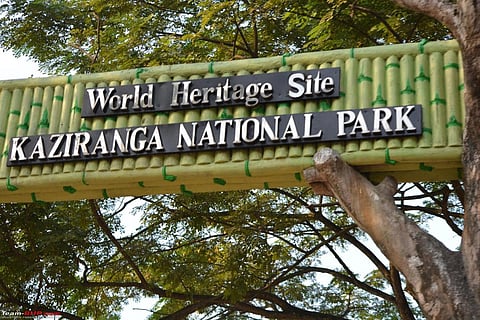
New Delhi: In a remarkable discovery within Kaziranga National Park, Assam, two previously unidentified species have come to light, shedding light on the park’s diverse ecosystem.
This groundbreaking revelation stems from the efforts of the people at Kaziranga like Chirantanu Saikia, a passionate tour guide and photographer hailing from Tezpur, and Arun Vignesh, the divisional forest officer of Eastern Assam Wildlife.
The first of these newfound species is the binturong, also known as the bearcat. Found primarily in South and Southeast Asia, this nocturnal mammal boasts a distinctive appearance and behaviour, preferring arboreal habitats and exhibiting a shy demeanour.
Its presence in Kaziranga, captured through Saikia’s lens during a January 2024 jeep safari in the Burapahar range, adds to the park’s biological diversity. However, the binturong’s rarity and vulnerability to extinction, particularly within its Indian range, emphasizes the importance of conservation efforts to safeguard its future.
The second species identified is the small-clawed otter, recognized as the world’s smallest otter species. These aquatic mammals, known for their adaptability to various aquatic environments, inhabit rivers, streams, lakes and wetlands across South and Southeast Asia.
Vignesh’s contribution in capturing a photograph of this otter within Kaziranga highlights the park’s significance as a habitat for diverse wildlife. Yet, like the binturong, the small-clawed otter faces threats such as habitat loss and poaching, emphasizing the urgent need for conservation measures to protect its vulnerable population.
The discovery of these two species does not only enrich understanding of Kaziranga’s biodiversity but also raises the importance of the critical role of conservation efforts in preserving fragile ecosystems.
Importance and History of Kaziranga National Park
In recognition of its ecological significance and remarkable biodiversity, Kaziranga National Park was inscribed as a UNESCO World Heritage Site in 1985, joining the ranks of the world’s most esteemed natural wonders.
Furthermore, in response to the conservation challenges faced by the region, the Indian government took proactive measures by establishing the Kaziranga Tiger Reserve in August 2006, reinforcing efforts to protect the park’s iconic species and their habitats.
Nestled in the picturesque landscapes of Assam, the reserve stands as one of India’s earliest and most revered sanctuaries. Spanning across the regions of Nagaon, Sonitpur and Golaghat, this reserve boasts a rich biodiversity, thanks to its strategic location within the Brahmaputra River floodplain.
Here, fertile soil teeming with alluvial deposits nurtures a thriving ecosystem, sustained by the network of small rivers that meander through the park before merging into the Brahmaputra.
Covering an area of 1,030 square kilometers, Kaziranga National Park holds the distinction of being the largest protected area on the southern bank of the Brahmaputra. Since its inception, the park has been under the watch of the Assam government’s environment department.
Initially established as a Reserve Forest in 1905, Kaziranga was conceived with the primary objective of safeguarding the Indian rhinoceros and its habitat. Over the years, its conservation status evolved, transitioning into a Game Reserve in 1916 and later attaining the designation of a Wildlife Sanctuary in 1950.
Finally, on January 1, 1974, Kaziranga was elevated to the esteemed status of a national park, solidifying its role as a sanctuary for diverse flora and fauna.
You can also join our WhatsApp group to get premium and selected news of The Mooknayak on WhatsApp. Click here to join the WhatsApp group.